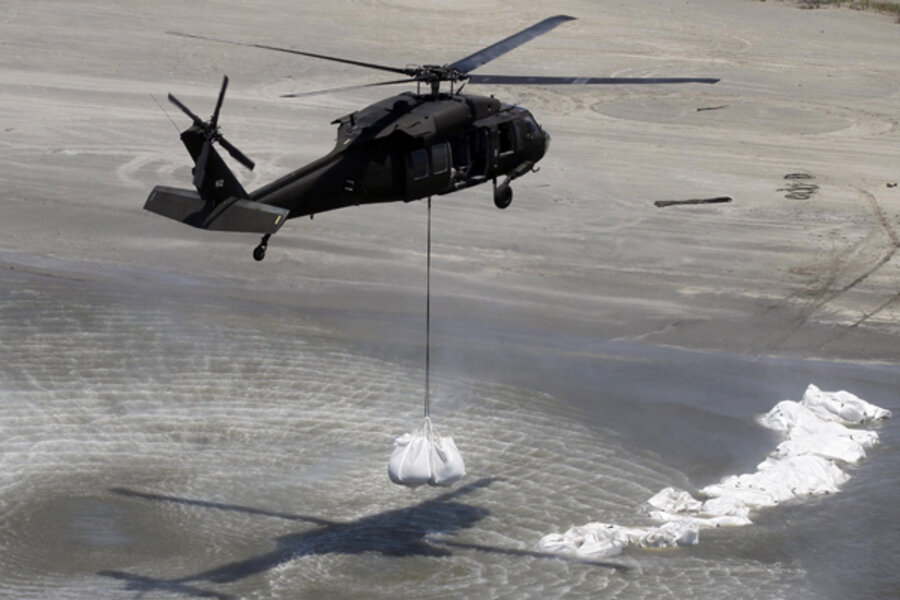Military helicopters drop sandbags as oil spill cleanup efforts continue off Louisiana
Loading...
| On the Gulf of Mexico
Black Hawk helicopters peppered Louisiana's barrier islands with 1-ton sacks of sand Monday to bolster the state's crucial wetlands against the epic Gulf of Mexico oil spill — 4 million gallons (15 million liters) and growing.
At the site of the ruptured well a mile (1.6 kilometer) underwater, a remote-controlled submarine shot chemicals into the maw of the massive leak to dilute the flow, further evidence that BP expects the gusher to keep erupting into the Gulf for weeks or more.
Crews using the deep-sea robot attempted to thin the oil — which is rushing up from the seabed at a pace of about 210,000 gallons (795,000 liters) per day — after getting approval from the Environmental Protection Agency, BP PLC officials said.
IN PICTURES: Louisiana oil spill
Two previous tests were done to determine the potential impact on the environment, and the third round of spraying was to last into early Tuesday.
The EPA said the effects of the chemicals were still widely unknown.
BP engineers were casting about after an icelike buildup thwarted their plan to siphon off most of the leak using a 100-ton containment box. They pushed ahead with other potential short-term solutions, including using a smaller box and injecting the leak with junk such as golf balls and pieces of tire to plug it. If it works, the well will be filled with mud and cement and abandoned.
"This is the largest, most comprehensive spill response mounted in the history of the United States and the oil and gas industry," BP chief executive Tony Hayward said in Houston.
None of those methods has been attempted so deep. Workers were simultaneously drilling a relief well, the solution considered most permanent, but that was expected to take up to three months.
At least 4 million gallons (15.14 million liters) were believed to have leaked since an April 20 drilling rig blast killed 11. If the gusher continues unabated, it would surpass the Exxon Valdez disaster as America's worst spill by June 20. About 11 million gallons (41.6 million liters) leaked in Alaska's Prince William Sound from the tanker in 1989.
The new containment device is much smaller, about 4 feet (1.2 meters) in diameter, 5 feet (1.5 meters) tall and weighing just under 2 tons, said Doug Suttles, BP PLC chief operating officer. Unlike the bigger box, it will be connected to a drill ship on the surface by a pipe-within-a-pipe when it's lowered, which will allow crews to pump heated water and methanol immediately to prevent the ice buildup.
In Grand Isle, at the tip of the Louisiana boot, a small army of heavy machinery — civilian and military dump trucks, Army jeeps and Hummers, front-end loaders and backhoes — scurried to fortify a breached section of beach. National Guard helicopters had dropped sandbags on the breach, and later piles of dirt were being pushed together to make a dam, keeping oil from reaching the marshes.
As the sandbags plopped in place, workers farther inland used pumps and other structures to divert fresh water from the Mississippi River into the marshlands, hoping it would help push back the oily salt water lapping at the coast. The floodworks had been installed to help rebuild Louisiana's shrinking wetlands by injecting sediment-rich water from the river.
"We're trying to save thousands of acres of marsh here in this area, where the shrimp lay their eggs, where the fin fish lay their eggs, where the crabs come in and out," said Chett Chiasson, executive director of the Greater Lafourche Port Commission. "We're trying to save a heritage, a way of life, a culture that we know here in recreational and commercial fishing."
BP — which is responsible for the cleanup — said the spill has cost it $350 million so far for immediate response, containment efforts, commitments to the Gulf Coast states, and settlements and federal costs. The company did not speculate on the final bill, which most analysts expect to run into tens of billions of dollars.
Above the oil leak, waves of dark brown and black sludge crashed into the support ship Joe Griffin. The fumes there were so intense that a crew member and an AP photographer on board had to wear respirators while on deck.
Oil — be it a surface sheen, globules or balls of tar — has washed up west of the Mississippi River and as far east as Dauphin Island, three miles off the Alabama mainland at the mouth of Mobile Bay.
The blowout aboard the rig, which was being leased by BP, was triggered by a bubble of methane gas that escaped from the well and shot up the drill column, expanding quickly as it burst through several seals and barriers before exploding, according to interviews with rig workers conducted during BP's initial, internal probe. The exact cause remains under investigation.
Related stories:
Tricky maneuver: Will containment cap stop the BP oil spill?
Current timeline to shut down Gulf of Mexico oil spill: three months
Oil spill's human impact: Oil and fish define south Louisiana's working life





